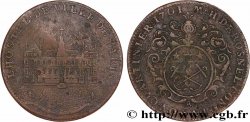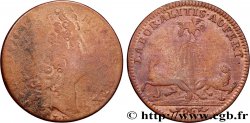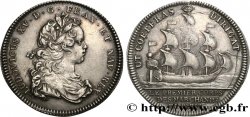fjt_058660 - CORPORATIONS Société royale de la savonnerie 1827
180.00 €(Approx. 192.60$ | 154.80£)
Quantity
Add to your cart

Type : Société royale de la savonnerie
Date: 1827
Metal : silver
Diameter : 34 mm
Orientation dies : 12 h.
Weight : 19,55 g.
Edge : lisse
Rarity : R3
Coments on the condition:
Petites marques de manipulation mais exemplaire tout à fait correct
Obverse
Obverse legend : CHARLES X ROI DE - FRANCE ET DE NAV..
Obverse description : Tête nue à droite, sur la tranche du cou signature E. DUBOIS. et au-dessous DE PUYMAURIN D..
Reverse
Reverse legend : SOCIÉTÉ ROYALE DE LA SAVONNERIE// FONDÉE EN 1827.
Reverse description : Caducée entre une tête de brebis et un couteau à tondre et une navette croisés, signature CAQUÉ - FECIT autour du caducée.
Commentary
NOtre jeton a été frappé pour la réunion aux Gobelins.
La Manufacture de la Savonnerie est une manufacture royale de tapisseries située à Paris et Lodève et faisant actuellement partie de la Manufacture des Gobelins.
La manufacture était à l'origine spécialisée dans la fabrication de tapis veloutés ainsi que des garnitures de siège. Ces tapis étaient utilisés par la cour de France ou comme présents royaux. Ce sont des tapis souvent de grandes dimensions, d'une qualité exceptionnelle. Ceux tissés sur les cartons de Charles Le Brun pour la Grande galerie du Palais du Louvre sont parmi les plus célèbres.
La suite à http://fr.wikipedia.org/wiki/Manufacture_de_la_Savonnerie.
La Manufacture de la Savonnerie est une manufacture royale de tapisseries située à Paris et Lodève et faisant actuellement partie de la Manufacture des Gobelins.
La manufacture était à l'origine spécialisée dans la fabrication de tapis veloutés ainsi que des garnitures de siège. Ces tapis étaient utilisés par la cour de France ou comme présents royaux. Ce sont des tapis souvent de grandes dimensions, d'une qualité exceptionnelle. Ceux tissés sur les cartons de Charles Le Brun pour la Grande galerie du Palais du Louvre sont parmi les plus célèbres.
La suite à http://fr.wikipedia.org/wiki/Manufacture_de_la_Savonnerie.








 Report a mistake
Report a mistake Print the page
Print the page Share my selection
Share my selection Ask a question
Ask a question Consign / sell
Consign / sell
 Full data
Full data



